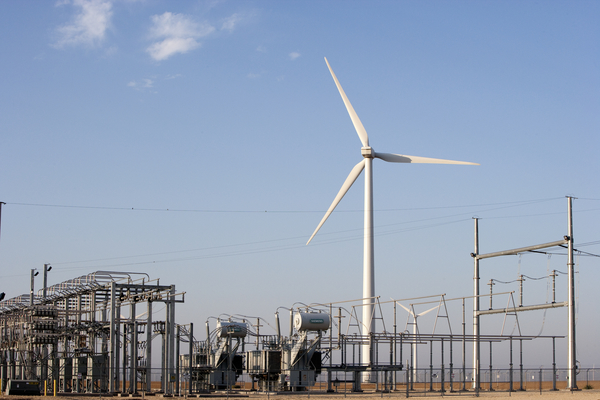
Photo: ©albradenphoto.com
By Cyrus Reed
“It’s a New Day in Texas” exclaimed new Lt. Governor Dan Patrick this week. It’s a new year too, which gives wind and solar power another chance to break more records. According to recent reports from the Electric Reliability Council of Texas (ERCOT), the grid operator for most of the state, wind power broke a few of their own records in 2014, and solar is gaining ground. But what’s coming down the line in 2015 and beyond?
First, let’s look at the great year wind had.
The latest monthly reports from ERCOT showed that wind power provided approximately 10.6 percent of all electricity used in ERCOT, just 1 percent behind nuclear generation. This was the first time wind power broke the 10 percent barrier.
Texas wind power set a new record of 10,957 MW of generation on December 25. Its previous generation record was 10,808 MW set the previous month.
ERCOT also recorded a new wind generation record on December 14. Are you ready for this? On that day, wind represented 39.7 percent of total system load. The previous record was 39.4 percent set on March 31.

Source:ERCOT, 2014 Demand and Energy Report

Where is the market heading?
A look at the December 2014 “Generation Interconnection Status” (GIS) report shows that planned development in Texas continues to be a mix of natural gas, wind, and increasingly solar, despite relatively low electricity prices.
Developers continue to plan for additional natural gas resources – both peaker plants and combined-cycle plants. 30,862 MW of natural gas are under development in the ERCOT market. Wind came in second at 23,392 MW, while solar continues to make impressive gains, with 6,425 MW being planned, mainly in West Texas.
It is likely that only a portion of these plants will get built over the coming years, but the GIS report is a good indication of what generation resources the market is choosing
Notice anything more about the chart below?
Nuclear? None.
Coal? One plant – the Summit plant near Odessa, which would use a new technology to capture carbon dioxide and is being heavily subsidized by the federal government – is still on the list.
There are also two major large-scale storage resources on the list as well.

ERCOT’s “Crystal Ball”
Finally, ERCOT released a series of reports in December that look into the future, which looks particularly bright for solar power.
The three reports – the 2014 Constraints and Needs Report, the 2014 Regional Transmission Plan Report, and the 2014 Long Term System Assessment Report (LTSA) – lay out both the challenges and opportunities facing continued reliability and resources within the ERCOT market. The three reports can be accessed here -- http://www.ercot.com/news/presentations.
The first two reports detail some of the challenges to keep the electric system healthy (in particular the need for more transmission around Houston, the Lower Rio Grande Valley, and Dallas area). The LTSA Report lays out various scenarios and what, if any, transmission and rule changes will be needed to meet electric demand. Thus, the LTSA Report is ERCOT’s “crystal ball” into the future, influenced by information from utilities and market participants.
The report lays out 10 different scenarios, including scenarios with continued development of environmental safeguards and regulations, scenarios with much higher penetration of demand side solutions like energy efficiency and onsite solar, and scenarios with rapid economic growth, such as would be expected if Texas becomes a major exporter of oil and gas through natural gas export terminals. While the scenarios diverge significantly, what is more apparent is that some trends are true in all of the scenarios.
In all scenarios, there will be some need for additional transmission upgrades around Houston, Dallas, and the Valley (and potentially West Texas). In all trends, onsite and utility-scale solar become major resources in the ERCOT mix and in all scenarios both gas and wind were important components of the future ERCOT mix.
In the Current Trends scenario, ERCOT projects that an additional 10,100 MW of utility-scale solar would be added, along with approximately 12,000 MW of new natural gas additions by 2029. Along the way, about 8,000 MW of older natural gas and coal units would retire.
The Stringent Environmental Scenario predicts much higher penetration of wind and solar. Under this scenario, ERCOT assumes that the proposed EPA protections – such as for haze pollution, the Clean Power Plan, as well as regulations to lower water usage – are fully implemented. In this case, solar power would add approximately 17,500 MW of power, while wind would add over 13,000 MW of power by 2029. Coal generation would be reduced to less than 5 percent of total generation by 2029 and wind and solar would generate nearly 30 percent of all power. Interestingly, other scenarios – including high economic growth or high natural gas prices – also show significant expansion of wind and solar power within ERCOT.
While no one can predict the future, or the expansion of new technologies like energy storage and demand response, the ERCOT reports suggest that ERCOT’s future will include a smaller role for coal power, and a larger role for wind and solar power. It is important to note that while ERCOT does predict higher costs in all scenarios – particularly for transmission needs – all scenarios suggest that ERCOT can keep reserve margins above 10 percent and keep the lights on, in part by using new resources like demand response, storage, and faster-responding more modern gas plants.
As the Legislature ramps up in 2015, we are hopeful Texas leaders will embrace this future with more wind and solar and less, or hopefully no, coal.